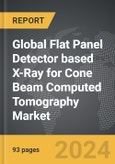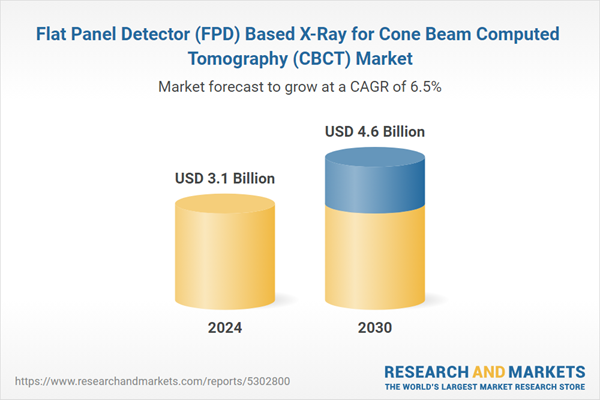Global Flat Panel Detector (FPD) Based X-Ray Market for Cone Beam Computed Tomography (CBCT) - Key Trends & Drivers Summarized
How Is FPD Technology Revolutionizing Cone Beam Computed Tomography (CBCT) Imaging?
Flat Panel Detector (FPD) technology has emerged as a game-changer in the field of Cone Beam Computed Tomography (CBCT), particularly in medical imaging applications. Unlike traditional image intensifier systems, FPD-based X-ray systems offer higher resolution, faster image acquisition, and reduced radiation doses, making them the preferred choice for CBCT. These detectors use advanced semiconductor materials, such as amorphous silicon or cadmium zinc telluride, to capture X-rays and convert them into high-quality digital images. This shift toward FPD-based systems is primarily driven by the need for more precise imaging in dental, orthopedic, and maxillofacial surgeries, where CBCT is increasingly used for its ability to produce 3D images with excellent spatial resolution. FPD-based X-ray systems offer significant advantages in terms of image quality and patient safety. The ability to capture fine details at a lower dose of radiation is particularly important in dental and maxillofacial applications, where patients may require multiple scans. Moreover, the compact size of FPDs has enabled the development of smaller, more mobile CBCT systems, making them suitable for use in outpatient clinics and private practices. This has increased the accessibility of CBCT technology to a wider range of healthcare providers, further boosting the adoption of FPD-based systems. Additionally, FPD technology supports faster image processing, reducing the time needed for diagnosis and treatment planning, thereby improving patient throughput and overall clinical efficiency.What Are the Key Technological Developments in FPD-Based CBCT Systems?
Recent technological advancements have significantly enhanced the capabilities of FPD-based X-ray systems for CBCT, particularly in terms of image clarity, versatility, and diagnostic accuracy. One of the most notable advancements is the integration of artificial intelligence (AI) and machine learning algorithms into FPD-based CBCT systems. These technologies are enabling more precise image reconstruction and automatic anomaly detection, improving diagnostic accuracy and reducing the likelihood of human error. AI-driven CBCT systems can analyze images in real-time, identifying potential issues such as bone fractures, dental caries, or tumor formations with greater speed and accuracy than traditional methods. This capability is especially valuable in dental and maxillofacial imaging, where early detection of abnormalities is critical to successful treatment outcomes. Another significant development in FPD-based CBCT systems is the enhancement of dynamic range and contrast resolution. These improvements allow for clearer differentiation of soft tissues, bones, and dental structures, making CBCT more useful for complex diagnostics such as temporomandibular joint (TMJ) assessments or sinus pathology. In addition, advancements in software integration have improved the 3D visualization capabilities of FPD-based CBCT systems, allowing for more detailed anatomical models that can be used in pre-surgical planning and simulation. The ongoing refinement of FPD sensors, particularly in reducing noise and improving low-dose performance, has also contributed to making CBCT more patient-friendly, with lower exposure to radiation without compromising image quality.Why Is the Demand for FPD-Based CBCT Systems Increasing in Healthcare?
The demand for FPD-based CBCT systems is growing rapidly due to their diverse applications across various medical disciplines. In dentistry, these systems are used for a wide range of diagnostic purposes, from implant planning and orthodontic assessments to the detection of impacted teeth and jaw abnormalities. Their ability to provide accurate 3D images of the craniofacial region makes them invaluable tools for oral surgeons and orthodontists. Additionally, in the field of orthopedics, CBCT is increasingly being used for imaging extremities, such as hands, wrists, and ankles, where high-resolution 3D scans can help in the diagnosis of fractures, dislocations, and other skeletal disorders. The rising prevalence of dental and orthopedic conditions, coupled with the growing awareness of the benefits of early and accurate diagnosis, is driving the adoption of FPD-based CBCT systems in both hospital and outpatient settings. Furthermore, the use of FPD-based CBCT is expanding beyond traditional medical applications, finding use in veterinary medicine and even industrial non-destructive testing (NDT). In veterinary clinics, CBCT is being adopted for imaging small animals, providing veterinarians with detailed 3D images for diagnosing bone and dental problems. In the industrial sector, FPD-based CBCT systems are being used to inspect complex mechanical parts and materials for defects, offering high-resolution imaging capabilities that rival traditional CT systems but at a lower cost. These diverse applications are driving the growth of the FPD-based CBCT market, as the technology becomes more versatile and accessible.What Are the Major Growth Drivers for the FPD-Based X-Ray for CBCT Market?
The growth in the FPD-based X-ray for CBCT market is driven by several factors, including advancements in technology, the increasing prevalence of dental and orthopedic conditions, and the growing demand for low-dose, high-resolution imaging systems. One of the primary drivers is the superior image quality provided by FPD technology, which has made it the preferred choice for healthcare providers seeking detailed 3D imaging for diagnostic and treatment purposes. The ongoing trend toward minimally invasive diagnostic procedures, where accurate imaging plays a crucial role, is also contributing to the market's growth. Additionally, the integration of AI and machine learning into CBCT systems is enhancing diagnostic accuracy and streamlining workflows, further boosting the appeal of these systems. The growing geriatric population, which is more prone to dental, orthopedic, and maxillofacial conditions, is another significant driver of market growth. As this demographic expands, the demand for advanced imaging solutions, particularly those that offer quick, accurate, and low-radiation diagnostic capabilities, is expected to rise. Moreover, regulatory support for the adoption of low-dose imaging technologies is encouraging healthcare providers to invest in FPD-based CBCT systems. Lastly, the expansion of outpatient clinics and dental practices, where mobile and compact FPD-based CBCT systems are increasingly used, is further propelling market growth by making these advanced imaging systems more widely available.Report Scope
The report analyzes the Flat Panel Detector (FPD) based X-Ray for Cone Beam Computed Tomography (CBCT) market, presented in terms of market value (US$ Thousand). The analysis covers the key segments and geographic regions outlined below.- Segments: Application (Orthopedics, Dental, ENT, Other Applications); End-Use (Hospitals, Clinics, Diagnostic Centers, Other End-Uses).
- Geographic Regions/Countries:World; United States; Canada; Japan; China; Europe (France; Germany; Italy; United Kingdom; Spain; Russia; and Rest of Europe); Asia-Pacific (Australia; India; South Korea; and Rest of Asia-Pacific); Latin America (Argentina; Brazil; Mexico; and Rest of Latin America); Middle East (Iran; Israel; Saudi Arabia; United Arab Emirates; and Rest of Middle East); and Africa.
Key Insights:
- Market Growth: Understand the significant growth trajectory of the Orthopedics Application segment, which is expected to reach US$2.9 Billion by 2030 with a CAGR of a 6.1%. The Dental Application segment is also set to grow at 7.9% CAGR over the analysis period.
- Regional Analysis: Gain insights into the U.S. market, valued at $815.5 Million in 2024, and China, forecasted to grow at an impressive 9.7% CAGR to reach $1.1 Billion by 2030. Discover growth trends in other key regions, including Japan, Canada, Germany, and the Asia-Pacific.
Why You Should Buy This Report:
- Detailed Market Analysis: Access a thorough analysis of the Global Flat Panel Detector (FPD) based X-Ray for Cone Beam Computed Tomography (CBCT) Market, covering all major geographic regions and market segments.
- Competitive Insights: Get an overview of the competitive landscape, including the market presence of major players across different geographies.
- Future Trends and Drivers: Understand the key trends and drivers shaping the future of the Global Flat Panel Detector (FPD) based X-Ray for Cone Beam Computed Tomography (CBCT) Market.
- Actionable Insights: Benefit from actionable insights that can help you identify new revenue opportunities and make strategic business decisions.
Key Questions Answered:
- How is the Global Flat Panel Detector (FPD) based X-Ray for Cone Beam Computed Tomography (CBCT) Market expected to evolve by 2030?
- What are the main drivers and restraints affecting the market?
- Which market segments will grow the most over the forecast period?
- How will market shares for different regions and segments change by 2030?
- Who are the leading players in the market, and what are their prospects?
Report Features:
- Comprehensive Market Data: Independent analysis of annual sales and market forecasts in US$ Million from 2024 to 2030.
- In-Depth Regional Analysis: Detailed insights into key markets, including the U.S., China, Japan, Canada, Europe, Asia-Pacific, Latin America, Middle East, and Africa.
- Company Profiles: Coverage of players such as ASAHI ROENTGEN IND.CO., LTD., Carestream Health, Cefla s.c. (NewTom S.C), CurveBeam, Danaher and more.
- Complimentary Updates: Receive free report updates for one year to keep you informed of the latest market developments.
Some of the 42 companies featured in this Flat Panel Detector (FPD) based X-Ray for Cone Beam Computed Tomography (CBCT) market report include:
- ASAHI ROENTGEN IND.CO., LTD.
- Carestream Health
- Cefla s.c. (NewTom S.C)
- CurveBeam
- Danaher
- Dentsply Sirona
- Genoray Co., Ltd.
- i-CAT
- J. Morita Corp.
- Owandy Radiology
- PLANMECA OY
- PointNix Co., Ltd
- Ray Co. Ltd
- Teledyne DALSA Inc.
- Varex Imaging Corporation
- VATECH
- Xoran Technologies, LLC
This edition integrates the latest global trade and economic shifts into comprehensive market analysis. Key updates include:
- Tariff and Trade Impact: Insights into global tariff negotiations across 180+ countries, with analysis of supply chain turbulence, sourcing disruptions, and geographic realignment. Special focus on 2025 as a pivotal year for trade tensions, including updated perspectives on the Trump-era tariffs.
- Adjusted Forecasts and Analytics: Revised global and regional market forecasts through 2030, incorporating tariff effects, economic uncertainty, and structural changes in globalization. Includes historical analysis from 2015 to 2023.
- Strategic Market Dynamics: Evaluation of revised market prospects, regional outlooks, and key economic indicators such as population and urbanization trends.
- Innovation & Technology Trends: Latest developments in product and process innovation, emerging technologies, and key industry drivers shaping the competitive landscape.
- Competitive Intelligence: Updated global market share estimates for 2025, competitive positioning of major players (Strong/Active/Niche/Trivial), and refined focus on leading global brands and core players.
- Expert Insight & Commentary: Strategic analysis from economists, trade experts, and domain specialists to contextualize market shifts and identify emerging opportunities.
Table of Contents
Companies Mentioned (Partial List)
A selection of companies mentioned in this report includes, but is not limited to:
- ASAHI ROENTGEN IND.CO., LTD.
- Carestream Health
- Cefla s.c. (NewTom S.C)
- CurveBeam
- Danaher
- Dentsply Sirona
- Genoray Co., Ltd.
- i-CAT
- J. Morita Corp.
- Owandy Radiology
- PLANMECA OY
- PointNix Co., Ltd
- Ray Co. Ltd
- Teledyne DALSA Inc.
- Varex Imaging Corporation
- VATECH
- Xoran Technologies, LLC
Table Information
| Report Attribute | Details |
|---|---|
| No. of Pages | 285 |
| Published | December 2025 |
| Forecast Period | 2024 - 2030 |
| Estimated Market Value ( USD | $ 3.1 Billion |
| Forecasted Market Value ( USD | $ 4.6 Billion |
| Compound Annual Growth Rate | 6.5% |
| Regions Covered | Global |









